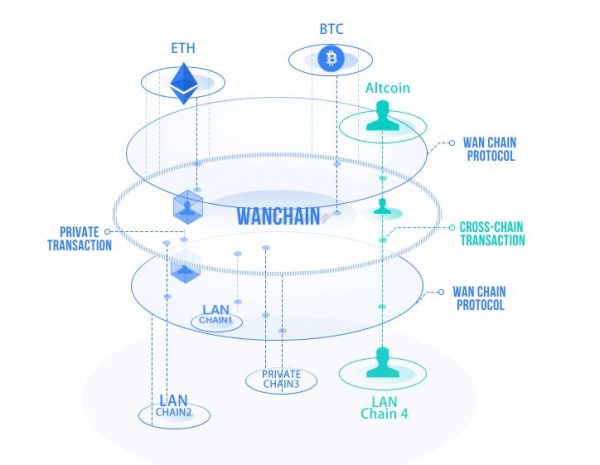Blockchain technology has been in existence for over 10 years now and various projects have sprang up in that time. Blockchain is quite simply an advancement over traditional databases, making information unalterable (hence, transparent), decentralized (hence, very difficult to hack), and seamlessly moveable (hence, easily transferred).
Currently, this transfer or exchange of value is only seamless when it occurs within one blockchain. To achieve blockchain’s full potential, it must be possible to exchange value or information across 2 different blockchains.
The idea of different blockchains interacting with one another is known as interoperability. One blockchain project aiming to solve this interoperability puzzle is Wanchain. If you are unfamiliar with the project, please read our introduction to Wanchain.
An illustration of the Wanchain architecture can be seen below:

The goal of Wanchain is to be able to seamlessly integrate with almost any blockchain.
To this effect, Wanchain announced on July 23, 2018 that the Wanchain 2.0 is live. Among many other upgrades, the most phenomenal feature of Wanchain 2.0 is its interoperability with Ethereum.
Wanchain 2.0 Ethereum Interoperability Feature
Ether can now be transferred cross-chain from Ethereum’s blockchain and accurately represented 1:1 on the Wanchain platform with a token known as WETH (Wanchain’s Ethereum Mapping Token). This function is made possible through a combination of smart contracts, secure multi-party computing, and threshold key sharing.
Secure Multi-Party Computation
Secure Multi-Party Computation is a unique feature that ensures parties can compute functions over inputs while keeping the inputs private. With threshold key sharing, nodes are not able to view the private data they are handling as keys (both private and public) are shared among various nodes in the network.
Wanchain is the first interoperable network to use secure multi-party computation (sMPC), threshold key sharing, and locked accounts mechanism.
Wanchain Interoperability Use Cases
The vision of Wanchain is to be the network that interconnects private and public blockchains and dapps. The interconnection with Ethereum is the first step in this vision.
The use cases of Wanchain’s interoperability include (but are not restricted to):
- Finance: Examples include decentralized exchanges, decentralized lending in crypto and fiat, multi-coin ICO, multi-asset management, crypto payment.
- Supply chain logistics: Improving the ability to trace goods through the different blockchains (the goods passed through) from that of the manufacturer to the retailer.
- Medical: This entails the transfer of patient medical records from the blockchain of a hospital to another (when a patient is transferred) without exposing the privacy of the patient.
- Identification: Countries with different identification blockchains can interact and verify the identities of travelling citizens. This makes passport forgeries almost impossible.
Upcoming Wanchain Developments
The following Wanchain developments are expected before the end of 2018:
- As the cross-chain function gets stabilized in later upgrades of Wanchain 2.0, registration will be open for Storeman nodes. Also, distributed large-scale Storeman participation in the cross-chain ecosystem will be established. (Storemen nodes are responsible for maintaining and managing the appropriate key shares of locked accounts for transactions. Wanchain uses Locked Account Generation Scheme to secure funds and keys when there are multiple parties involved.
- Cross-chain support with Bitcoin and with 1 or 2 ERC-20 tokens.
- Improvement of Storeman consensus mechanism, including a penalty mechanism for malicious acts and negligence by Storeman nodes.
For 2019, expected developments include:
- Reward for developers to develop cross-chain functionality of tokens on other chains
- Improving Proof-of-Stake and enhancing in-chain and cross-chain transactions
Conclusion
The race to achieve interoperability among blockchain and dapps is one that involves a lot of blockchain projects. Projects like Icon, Aion, and Ark have similar purposes. However, Wanchain distinguishes itself by being the first, and currently the only, interoperable blockchain with secure multi-party computing.
Wanchain 2.0’s interoperability with Ethereum is expected to lead the way to integrations with other blockchains over the near term. Stay in touch with more announcements from Wanchain via Telegram, Twitter, and their blog.
Related: The Race for Cross-Chain Communication: 11 Projects Working on Blockchain Interoperability

